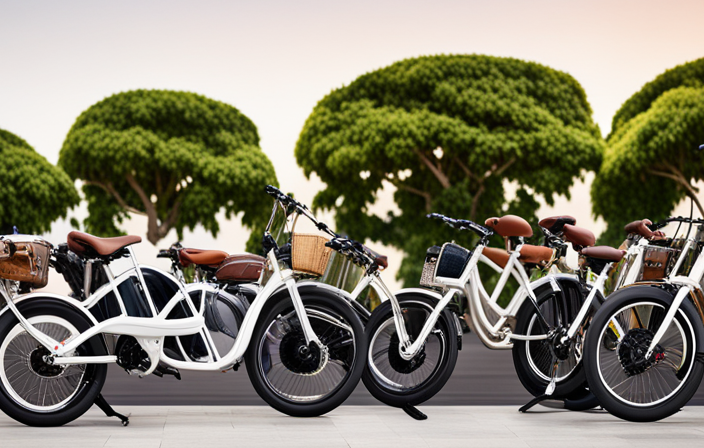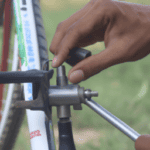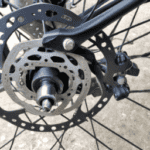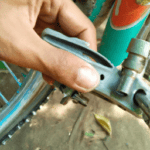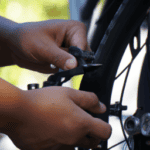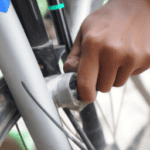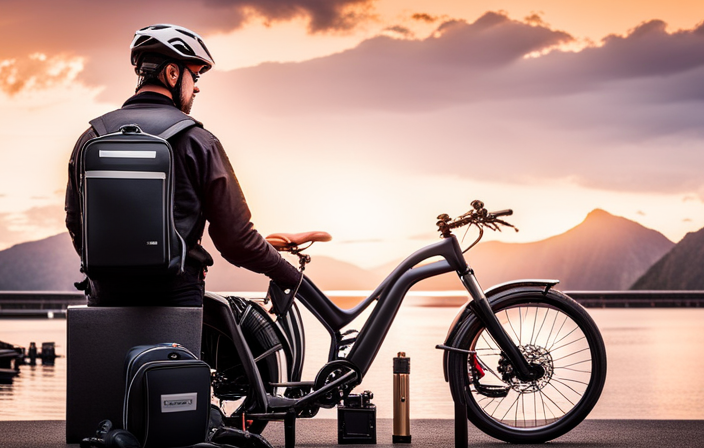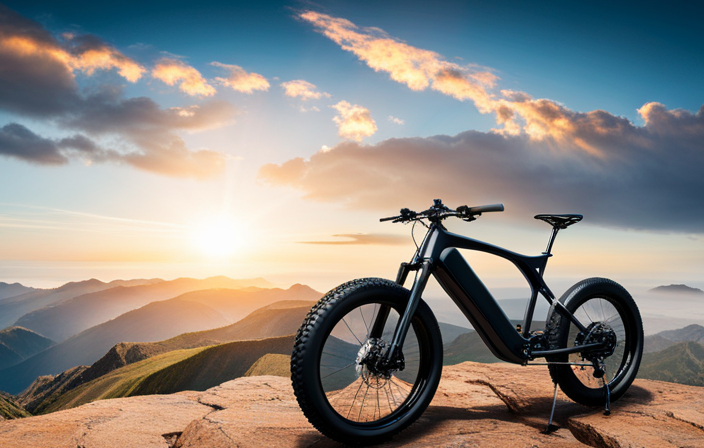Is the response from your electric bike’s brakes a little slow? No need to fret, I’m here to help.
In this article, I’ll guide you through the process of adjusting your electric bike brakes to ensure they’re working at their best. Properly functioning brakes are crucial for your safety and peace of mind while riding.
So, let’s dive in and learn how to fine-tune your brakes, so you can enjoy a smooth and worry-free biking experience.
Key Takeaways
- Properly functioning brakes are crucial for safety and the safety of others.
- Understanding the different types of electric bike brakes: rim brakes, disc brakes, and drum brakes.
- Gathering the necessary tools for brake adjustment: Allen wrench set, adjustable wrench, screwdriver, brake cable puller, and brake pad alignment tool.
- Adjusting and maintaining brakes: checking brake pads for wear and tear, adjusting brake cable tension, aligning brake pads, testing and fine-tuning brake performance, troubleshooting common brake problems, and regular maintenance and inspection.
Importance of Properly Functioning Brakes on an Electric Bike
You need to make sure your brakes on your electric bike are working properly because it is crucial for your safety and the safety of others. When riding an electric bike, you rely heavily on your brakes to slow down or stop, especially when going downhill or approaching intersections. Faulty brakes can lead to accidents and injuries, putting both you and others at risk.
Properly functioning brakes give you the confidence and control you need while riding, allowing you to react quickly to unexpected situations. Understanding the different types of electric bike brakes will further enhance your knowledge and enable you to adjust them effectively.
So, let’s dive into the next section and learn about the various brake systems available for electric bikes.
Understanding the Different Types of Electric Bike Brakes
To properly maintain your e-bike, it’s important to familiarize yourself with the various types of braking systems available.
There are three main types of electric bike brakes: rim brakes, disc brakes, and drum brakes.
Rim brakes work by pressing brake pads against the wheel rim, while disc brakes use calipers to squeeze brake pads against a rotor.
Drum brakes, on the other hand, have brake shoes that press against the inside of the wheel hub.
Each type of brake has its advantages and disadvantages, so it’s important to choose the one that best suits your riding style and terrain.
Understanding the different types of electric bike brakes will help you make informed decisions when it comes to adjusting and maintaining your brakes.
With that knowledge in mind, let’s move on to gathering the necessary tools for brake adjustment.
Gathering the Necessary Tools for Brake Adjustment
First, gather all the tools needed for adjusting the brakes on your e-bike. In order to properly adjust your electric bike brakes, you will need a few essential tools. Here is a helpful table outlining the necessary tools:
| Tools |
|---|
| Allen wrench set |
| Adjustable wrench |
| Screwdriver |
| Brake cable puller |
| Brake pad alignment tool |
Having these tools on hand will make the brake adjustment process much easier and more efficient. Once you have gathered all the necessary tools, you can move on to the next step of checking the brake pads for wear and tear. It is important to ensure that your brake pads are in good condition to maintain optimal braking performance.
Checking Brake Pads for Wear and Tear
Next, take a closer look at your brake pads to check for any signs of wear and tear. Inspect both the front and rear brake pads to ensure they are in good condition. Look for any uneven wear, excessive grooving, or thinning of the pad material. If you notice any of these issues, it’s time to replace the brake pads. Worn-out brake pads can significantly reduce braking performance and compromise your safety on the road.
Once you’ve determined that your brake pads are in good condition, you can move on to adjusting the brake cable tension. This step is crucial for ensuring that your brakes engage properly when you squeeze the brake lever. By adjusting the tension, you can achieve the right amount of stopping power without the brakes being too loose or too tight.
Adjusting Brake Cable Tension
Now, you need to make sure the tension of your brake cable is properly adjusted. Here are the steps to follow:
-
Start by loosening the bolt that holds the cable in place on the brake caliper.
-
Pull the cable tight with your hand and tighten the bolt back up.
-
Squeeze the brake lever to make sure the tension feels right. If it’s too loose, repeat steps 1 and 2. If it’s too tight, loosen the bolt and give the cable a bit more slack.
-
Finally, check that the brake pads are lined up properly with the rim or disc. They should make contact evenly when you squeeze the brake lever.
With the cable tension adjusted, you can now move on to aligning the brake pads for optimal contact with the rim or disc.
Aligning Brake Pads for Optimal Contact with the Rim or Disc
After adjusting the tension of the brake cable, the next step is to align the brake pads for optimal contact with the rim or disc. This is crucial for efficient braking and preventing any unwanted rubbing or squealing noises.
To align the brake pads, I start by loosening the bolt that holds the brake pad in place. Then, I squeeze the brake lever to position the pads evenly against the rim or disc. Once the pads are aligned, I tighten the bolt to secure them in place.
It’s important to check that both pads are making equal contact with the rim or disc to ensure balanced braking. With the pads properly aligned, I can move on to testing and fine-tuning the brake performance to ensure optimal stopping power.
Testing and Fine-Tuning Brake Performance
To ensure optimal stopping power, it’s important to test and fine-tune the performance of the brakes. Once the brake pads are aligned properly, I like to test the brakes by gradually applying pressure to the brake lever. I pay close attention to how quickly and smoothly the bike comes to a stop.
If the brakes feel too spongy or if there is excessive noise or vibration, adjustments may be necessary. I start by checking the brake cable tension and make any necessary adjustments using the barrel adjuster. Additionally, I inspect the brake pads for wear and replace them if needed. It’s also important to check for any loose or damaged brake components and fix them accordingly.
By testing and fine-tuning the brake performance, I can ensure that my electric bike has reliable stopping power.
Now, let’s move on to troubleshooting common brake problems.
Troubleshooting Common Brake Problems
If you’re experiencing any issues with your brake performance, troubleshooting common brake problems can help you identify and resolve the issue.
One common problem is squeaky brakes, which can be caused by contaminated brake pads or misalignment. To fix this, I would start by cleaning the brake pads and making sure they are properly aligned with the rotor.
Another issue could be weak brakes, which may be caused by worn brake pads or a loose cable. In this case, I would replace the brake pads if they are worn and tighten the cable if it’s loose.
Lastly, if your brakes feel too grabby or sensitive, it could be due to excessive brake pad wear or improper adjustment. To fix this, I would replace the brake pads if needed and adjust the brake caliper position.
Troubleshooting common brake problems is essential for maintaining optimal brake performance and ensuring your safety while riding. Speaking of safety, regular maintenance and inspection of electric bike brakes is also crucial to prevent any potential issues.
Regular Maintenance and Inspection of Electric Bike Brakes
Now that we’ve discussed troubleshooting common brake problems, let’s move on to the importance of regular maintenance and inspection of electric bike brakes.
As a bike enthusiast, I have found that taking the time to properly maintain and inspect my brakes not only ensures their optimal performance but also increases their lifespan. So, here are three key aspects to focus on during regular maintenance and inspection:
-
Check the brake pads: Over time, brake pads can wear down and lose their effectiveness. It’s crucial to regularly inspect and replace them if necessary.
-
Adjust the brake cables: Ensure that the brake cables are properly tensioned and aligned. Loose or misaligned cables can lead to inefficient braking.
-
Inspect the brake rotors: Examine the brake rotors for any signs of wear, warping, or damage. Damaged rotors should be replaced to maintain reliable braking performance.
By performing these regular maintenance tasks, you can keep your electric bike’s brakes in top condition. However, it’s important to note that for complex brake issues, seeking professional help is essential to ensure your safety and the proper functioning of your bike.
Importance of Seeking Professional Help for Complex Brake Issues
Seeking professional help is essential for complex brake issues to ensure your safety and the proper functioning of your bike. While regular maintenance and inspection can address minor brake issues, complex problems require the expertise of a trained professional.
They have the knowledge and experience to diagnose and fix intricate brake problems that may arise with electric bikes. Attempting to fix these issues on your own can lead to further damage or even accidents.
Professionals have access to specialized tools and equipment necessary for repairing complex brake systems. They can also provide valuable advice on how to properly maintain and care for your electric bike’s brakes, helping to extend their lifespan.
Don’t hesitate to seek professional assistance when dealing with complex brake issues to ensure your safety and the longevity of your electric bike.
Frequently Asked Questions
Can I use the same tools for adjusting electric bike brakes as I would for regular bike brakes?
Yes, you can use the same tools for adjusting electric bike brakes as you would for regular bike brakes. The process is similar, requiring tools like Allen wrenches, screwdrivers, and brake cable tension adjusters.
How often should I check my electric bike brake pads for wear and tear?
I should check my electric bike brake pads for wear and tear regularly to ensure they are in good condition. This will help me maintain optimal braking performance and avoid any potential safety issues.
Is it possible to over-tighten the brake cable when adjusting the tension?
It is possible to over-tighten the brake cable when adjusting the tension. Over-tightening can lead to brake drag or premature wear. It is important to find the right balance to ensure proper braking performance.
Can I use the same method for aligning brake pads on both rim and disc brakes?
Yes, you can use the same method for aligning brake pads on both rim and disc brakes. It involves loosening the mounting bolts, aligning the pads with the rim or rotor, and then tightening the bolts.
What are some common signs of brake problems that I should look out for during regular maintenance and inspection?
Some common signs of brake problems to look out for during regular maintenance and inspection include squeaking or grinding sounds, reduced braking performance, vibrations or pulsations when braking, and a soft or spongy brake lever feel.
Conclusion
So there you have it, the importance of properly functioning brakes on an electric bike can’t be overstated.
Understanding the different types of brakes, gathering the necessary tools, and regularly maintaining and inspecting your brakes are all crucial steps in ensuring your safety while riding.
And if you encounter any complex brake issues, don’t hesitate to seek professional help.
Remember, your brakes are your lifeline, so take the time to adjust them properly and ride with confidence.
Stay safe out there!

